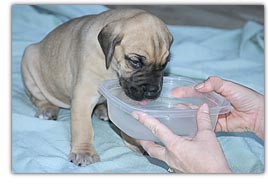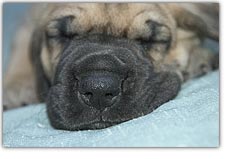 |
–
GOT MILK? –
May 10,
2004 – The puppies we've been following are now
24 days old. They are walking, talking, and they're very responsive to their
breeder,
Cindy Niske.
They even come when she calls! These "Seventh Heaven" babies are frisky
little critters, and they're learning to play. Their baby teeth are plenty sharp,
and while they sure like tugging on those tasty spigots attached
to their mother, that's not all they like to pull on. Furry tails, floppy ears,
fleshy fingers, dangling camera straps and loose blanket corners will do just
fine,
thank
you
very
much. It's
a
mighty
big
world
out
there, and
when you're a three-week-old puppy, there's plenty to explore.
Planning a Litter
This
week
we'll be
discussing
the "business-end" of
breeding a Great Dane. I think the general public has no idea what reputable
breeders
go through – and spend – to produce a litter of healthy,
high-quality
Great
Dane puppies. Today we'll talk mainly about health testing, an essential
part of planning a litter. Next week we'll take a closer look at
the labor involved – and I don't mean the dam's labor. Whelping and
raising Great Dane puppies is hard work.

Health Screening
Pre-breeding health checks
are a fundamental part of the breeding process. First off, it is important to
screen
for Brucellosis, a sexually-transmitted bacterial disease. Brucellosis is serious
stuff. A latent Brucellosis infection can kill the puppies and/or cause permanent
infertility. Female dogs should be tested a few weeks before they come into heat
and stud males should be tested twice a
year. Brucellosis testing runs $35-$50, depending on where you live.
Tests for heritable
(inherited) disorders should be performed as well. The Great Dane Club of America
(GDCA) recently joined the Canine Health Information Center (CHIC) program, and
the Club is now recommending
the following screenings:
Hip
Dysplasia – Results accepted from OFA, PennHIP, GDC, or OVC
 Eyes
Eyes – Results accepted from CERF
 Congenital Cardiac Disease
Congenital Cardiac Disease – Results accepted from OFA
 Autoimmune Thyroid Disease –
Autoimmune Thyroid Disease – Results accepted from OFA |
(For more info about GDCA's
relationship to CHIC, go here.)
I asked a seasoned breeder,
who I greatly admire, to give us a run-down of what all this
testing
might cost. Here's what she wrote:
OFA,
hips: This test costs approximately
$200 – or
more, if you go to an orthopedic specialist – plus a $30
registration fee for OFA. If you do hips and elbows at the same time,
the cost
is around $250, plus a $35 fee to OFA. Done separately, OFA registration
for hips is $30 and elbows is another $25.
 PennHip: If
I do PennHip and OFA at the same time, it runs me $450 plus the submission
fees. If done alone, it should be $250-300, depending on where you
have it done. (The veterinarian must be certified to do PennHip). PennHip: If
I do PennHip and OFA at the same time, it runs me $450 plus the submission
fees. If done alone, it should be $250-300, depending on where you
have it done. (The veterinarian must be certified to do PennHip).
CERF: If
done at a clinic, CERF usually runs ~$25 for the exam. You may have
to pay more at a vet school. (At Cornell University, for instance,
the examination fee has gone up to $75, due to cuts in state subsidies.)
CERF charges $10 to register, and $7.50 for updates. CERF certification
is supposed
to
be repeated
annually.
OFA, cardiac: Auscultation
(stethoscopic exam) is the only test required, as long as the results
are normal. You can get this done as cheaply as $25 at some clinics.
The OFA fee is $15. I prefer to do a full echocardiogram on all breeding
stock as a baseline, which I repeat every other year with
annual auscultation done in between. Some clinics will offer a limited
number of echoes for ~$100, but if you go to a specialist you should
expect to pay $250-300 for a basic echo with Doppler ultrasound. At
a minimum, I believe cardiac certification (auscultation and/or echo)
should be performed on a yearly basis.
 OFA, thyroid: Fees
vary greatly for thyroid testing, as there are several "parts" to
the process. There is always an office visit fee for drawing
and processing the dog's blood, a shipping fee for getting the blood
to the lab, a lab fee for testing the blood, and finally the actual
OFA fee, for registering the results. Here is what I pay: $25 for
the office visit, $13 to draw the blood, $45 for the lab fee if we
are doing a partial panel or $90 for full panel,
$36-56 for overnight shipping, and, finally, $15 for the OFA fee.
(There is no fee for submitting follow up reports, equivocal results
or failed results.) Thyroid certification should be performed on a
yearly basis. OFA, thyroid: Fees
vary greatly for thyroid testing, as there are several "parts" to
the process. There is always an office visit fee for drawing
and processing the dog's blood, a shipping fee for getting the blood
to the lab, a lab fee for testing the blood, and finally the actual
OFA fee, for registering the results. Here is what I pay: $25 for
the office visit, $13 to draw the blood, $45 for the lab fee if we
are doing a partial panel or $90 for full panel,
$36-56 for overnight shipping, and, finally, $15 for the OFA fee.
(There is no fee for submitting follow up reports, equivocal results
or failed results.) Thyroid certification should be performed on a
yearly basis.
I also
test for Von
Willebrand's disease, a bleeding disorder. vWD is not a widely found
in the Great Dane, but it is a devastating disease, and one I'd prefer to avoid
by screening. For some reason it
is
very
expensive
from my vet – $102
plus shipping and office
fees.
I usually
have vWD testing done at the same time as something else to avoid
being charged
for a separate office visit.
|
Whew... we're approaching $1000, and
we haven't even had a breeding yet! Believe me folks, that's just
the beginning. Next week we'll talk about the process of breeding
a Great Dane, taking care of the mother-to-be, and whelping a litter.
( I get tired just thinking about it.)
 In the meantime, here
is some additional information for those of you with inquiring minds.
Indeed, I think this is important information for anyone who is thinking
about buying a puppy. In the meantime, here
is some additional information for those of you with inquiring minds.
Indeed, I think this is important information for anyone who is thinking
about buying a puppy.
What is the CHIC program?
The Canine Health Information Center (CHIC)
is a centralized canine health database sponsored by the American
Kennel Club (AKC), its Canine Health
Foundation (CHF), and the Orthopedic
Foundation for Animals (OFA). For
breeders, CHIC offers a reliable source of information regarding
dogs they may wish to use in their breeding programs. For buyers, CHIC
offers reliable information about the results
of a breeder’s health testing.
What, exactly, is
OFA?
The Orthopedic Foundation
for Animals, or OFA, was established
in 1966 for the purpose of providing radiographic evaluation, database
maintenance, and breeding advice
to reduce the incidence of degenerative joint disease, or hip dysplasia,
in dogs. Over the past 10-15 years, OFA has expanded its mission to
include other heritable (inherited) diseases such as congenital cardiac
disease, autoimmune thyroid disease and Von
Willebrand's disease.
OFA, hip: Qualified
radiographs of canine hips are rated for soundness by a team of board-certified
veterinary radiologists appointed by OFA. Grades of excellent, good
and fair are considered to be within normal limits. If a dog qualifies
as normal, it is assigned an OFA number. The OFA evaluation number
and grade is accepted by the AKC for those dogs with permanent identification,
and their ranking is available to the public via
OFA's searchable database.
 OFA,
cardiac: OFA maintains a congenital cardiac database for dogs 12 months
of age and over. In order to participate, OFA requires a careful clinical examination,
performed (preferably) by a diplomat of the American College of Veterinary Internal
Medicine,
Specialty of Cardiology, or a veterinarian with advanced training
in the subspecialty of congenital heart disease. A dog is determined to be normal
if he is without cardiac murmur or if he has a heart murmur determined to be
otherwise normal, by virtue of an echocardiographic examination that includes
Doppler echocardiography. Other cardiac
murmurs
are graded "1" through "6," depending on the severity. OFA,
cardiac: OFA maintains a congenital cardiac database for dogs 12 months
of age and over. In order to participate, OFA requires a careful clinical examination,
performed (preferably) by a diplomat of the American College of Veterinary Internal
Medicine,
Specialty of Cardiology, or a veterinarian with advanced training
in the subspecialty of congenital heart disease. A dog is determined to be normal
if he is without cardiac murmur or if he has a heart murmur determined to be
otherwise normal, by virtue of an echocardiographic examination that includes
Doppler echocardiography. Other cardiac
murmurs
are graded "1" through "6," depending on the severity.
OFA, thyroid: Autoimmune
thyroiditis
is the
most common cause of primary hypothyroidism in dogs. It usually,
but not always, manifests at 2 to 5 years of age. To qualify for inclusion in
OFA's database, and to receive an OFA number, a dog must be examined by a veterinarian
and have a serum sample sent to an OFA-approved laboratory. Any dog 12 months
of age or older can be certified. OFA recommends that all dogs be reexamined
at ages 2,3,4,6, and 8 years.
 What is PennHIP? What is PennHIP?
The University of
Pennsylvania Hip Improvement Program, or PennHIP,
is a radiographic method of hip evaluation that can help predict the onset (or
presence) of degenerative
joint disease, which is the hallmark of canine
hip
dysplasia. PennHIP is a well-researched, objective method of evaluation
performed by trained veterinarians who follow PennHIP's
strict
scientific
protocols.
What
is CERF?
The Canine Eye Registration
Foundation, or CERF,
was established in conjunction with board certified, veterinary ophthalmologists.
CERF's goal is to eliminate heritable eye disease
in all purebred
dogs by forming a centralized, national registry. Certification, which involves
a painless examination of the dogs eyes by a qualified American College of Veterinary
Ophthalmologists (ACVO) diplomat, is good for 12 months from the date of the
exam. Afterwards
the dog must be reexamined and
re-certified
to maintain its CERF registration.
Next
Installment
Archived comments (10) |
©2002-2008
by Ginnie Saunders. All rights are reserved. No part of this web
site
may be reproduced or transmitted in any form or by any means —
electronic or mechanical, including photocopying, recording, or by
any information storage or retrieval system — without written
permission from Ginnie
Saunders. To learn more about copyright issues on the web,
visit the Web Law
FAQ.
Ginnie.com, Inc.
PO Box 50314
Columbia, SC 29250
(803) 783-3169
www.ginnie.com
|


|

![]()




 PennHip: If
I do PennHip and OFA at the same time, it runs me $450 plus the submission
fees. If done alone, it should be $250-300, depending on where you
have it done. (The veterinarian must be certified to do PennHip).
PennHip: If
I do PennHip and OFA at the same time, it runs me $450 plus the submission
fees. If done alone, it should be $250-300, depending on where you
have it done. (The veterinarian must be certified to do PennHip).  OFA, thyroid: Fees
vary greatly for thyroid testing, as there are several "parts" to
the process. There is always an office visit fee for drawing
and processing the dog's blood, a shipping fee for getting the blood
to the lab, a lab fee for testing the blood, and finally the actual
OFA fee, for registering the results. Here is what I pay: $25 for
the office visit, $13 to draw the blood, $45 for the lab fee if we
are doing a partial panel or $90 for full panel,
$36-56 for overnight shipping, and, finally, $15 for the OFA fee.
(There is no fee for submitting follow up reports, equivocal results
or failed results.) Thyroid certification should be performed on a
yearly basis.
OFA, thyroid: Fees
vary greatly for thyroid testing, as there are several "parts" to
the process. There is always an office visit fee for drawing
and processing the dog's blood, a shipping fee for getting the blood
to the lab, a lab fee for testing the blood, and finally the actual
OFA fee, for registering the results. Here is what I pay: $25 for
the office visit, $13 to draw the blood, $45 for the lab fee if we
are doing a partial panel or $90 for full panel,
$36-56 for overnight shipping, and, finally, $15 for the OFA fee.
(There is no fee for submitting follow up reports, equivocal results
or failed results.) Thyroid certification should be performed on a
yearly basis.

 What is PennHIP?
What is PennHIP?